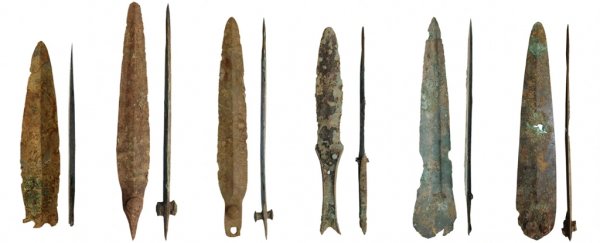Prehistoric daggers long thought to be non-functional ceremonial objects interred in warriors' graves were actually used to slaughter and butcher animals during the early fourth millennium BCE, a new study suggests.
Numerous copper-alloy daggers have been unearthed in Bronze Age warriors' graves across Europe, along with other weapons, and archaeologists previously speculated that the daggers may have served as status symbols.
But scientists used a new analysis method on a set of 10 daggers, found in Pragatto, Italy in 2017, to reveal evidence that the tools had a more practical purpose.
The new analysis "enabled the world's first extraction of organic residues" which revealed "for the first time, how these objects were used, for what tasks, and on what materials," researchers from Newcastle University in the UK said in a statement.
 The 10 daggers, along with a map showing the area of their discovery. (Newcastle University)
The 10 daggers, along with a map showing the area of their discovery. (Newcastle University)
Related: 10 stunning swords and other ancient weapons uncovered in 2021
The new research process uses a type of diagnostic dye called Pico-Sirius Red solution (PSR) to stain any organic residue that remains on the daggers, and scientists then examine this under a variety of different microscopes (including optical, digital and electron) to determine if any remains are still on the blade and if they are likely human or animal.
Through this process, the research team was able to determine that there were traces of type I and type II collagen (a protein found in skin, tissue and bone, according to Healthline), bone, muscle and bundle tendon fibers from numerous animals, the researchers wrote in the study, published April 12 in the journal Scientific Reports.
This suggests that the knives were used multiple times for different purposes, including slaughtering livestock and carving meat from the bone.
The researchers then independently validated their findings with a microwear analysis (a process of recording wear traces on artifacts, according to Texas Beyond History) on butchered animal remains from other Bronze Age sites, as these bones frequently have metal cut marks on them, the team wrote in the paper.
The team also utilized the skills of a bronzesmith and obtained a large number of replicas of different Bronze Age daggers and knives. They then compared the residue on these with that of the original daggers and saw that they matched.
"The research has revealed that it is possible to extract and characterize organic residues from ancient metals," Andrea Dolfini, a senior lecturer in later prehistory at Newcastle University said in the statement.
"The possibilities are endless, and so are the answers that the new method can and will provide in the future."
Related content:
Bronze Age 'infinity pool' hosted supernatural water rituals, archaeologists say
'Untouched' Bronze Age tomb containing human remains and a mysterious stone found in Ireland
Rare Bronze Age coffin uncovered on UK golf course
This article was originally published by Live Science. Read the original article here.
